tire type DODGE JOURNEY 2012 1.G User Guide
[x] Cancel search | Manufacturer: DODGE, Model Year: 2012, Model line: JOURNEY, Model: DODGE JOURNEY 2012 1.GPages: 108, PDF Size: 3 MB
Page 71 of 108

• Your vehicle has also been equipped with a TPMS malfunction indicator to indicatewhen the system is not operating properly. The TPMS malfunction indicator is
combined with the low tire pressure telltale. When the system detects a
malfunction, the telltale will flash for approximately one minute and then remain
continuously illuminated. This sequence will continue each time the vehicle is
restarted as long as the malfunction exists.
• When the malfunction indicator is illuminated, the system may not be able to detect or signal low tire pressure as intended. TPMS malfunctions may occur for a
variety of reasons, including the installation of replacement or alternate tires or
wheels on the vehicle that prevent the TPMS from functioning properly. Always
check the TPMS malfunction telltale after replacing one or more tires or wheels on
your vehicle, to ensure that the replacement or alternate tires and wheels allow the
TPMS to continue to function properly.
NOTE: Tire pressures change by approximately 1 psi (7 kPa) per 12° F (7° C) of air
temperature change. Keep this in mind when checking tire pressure inside a garage,
especially in the Winter. Example: If garage temperature is 68°F (20°C) and the outside
temperature is 32°F (0°C), then the cold tire inflation pressure should be increased by
3 psi (21 kPa), which equals 1 psi (7 kPa) for every 12°F (7°C) for this outside
temperature condition.
CAUTION!
The TPMS has been optimized for the original equipment tires and wheels.
TPMS pressures and warning have been established for the tire size equipped
on your vehicle. Undesirable system operation or sensor damage may result
when using replacement equipment that is not of the same size, type, and/or
style. Aftermarket wheels can cause sensor damage. Do not use tire sealant
from a can, or balance beads if your vehicle is equipped with a TPMS, as
damage to the sensors may result.
- Engine Temperature Warning Light
• This light warns of an overheated engine condition.
• If the light turns on and a warning chime sounds while driving, safely pull over and stop the vehicle. If the A/C system is on, turn it off. Also, shift the transmission
into NEUTRAL and idle the vehicle. If the temperature reading does not return to
normal, turn the engine off immediately.
• We recommend that you do not operate the vehicle or engine damage will occur. Have the vehicle serviced immediately.
WARNING!
A hot engine cooling system is dangerous. You or others could be badly burned
by steam or boiling coolant. You may want to call an authorized service center
for service if your vehicle overheats.
WHAT TO DO IN EMERGENCIES
69
Page 103 of 108

Air Conditioning............ 28
Airbag .................. 13
Alarm,Panic ............... 8
Arming Theft System
(Security Alarm) ............ 12
Audio Settings ........... 37,39
Automatic Headlights ......... 26
Automatic Temperature Control
(ATC) ................... 28
Automatic Transmission FluidType .............. 89
Auxiliary Audio/Video Input Jacks . . 59
AxleFluid ................ 89
Back-Up Camera ............ 31
Belts, Seat ............... 12
Booster Seat .............. 14
Brake Fluid ............... 89
Break-In Recommendations,
NewVehicle ............... 25
BulbReplacement ........... 97
Calibration,Compass ......... 60
ChangeOilIndicator .......... 71
ChangingAFlatTire .......... 73
Child Booster Seat ........... 14
Child Restraint ............. 14
Child Restraint Tether Anchors .... 15
Climate Control ............. 28
Clock Setting ............ 37,39
Compass Calibration .......... 60
Cooling System Coolant Capacity ........... 89
Cruise Control (Speed Control) .... 27
CruiseLight ............... 27
Customer Assistance .......... 98
Customer Programmable Features . . 61
Defects, Reporting ........... 99
Dimmer Control ............. 26
Dimmer Switch, Headlight ...... 26
Disarming, Theft System ....... 12
E-85Fuel ................ 90
Electronic Speed Control
(Cruise Control) ............. 27 Electronic Vehicle Information Center
(EVIC) ................ 60,61
Electronics
Your Vehicle's Sound System .... 34
Emergency Key .............. 8
Emergency, In Case of Freeing Vehicle When Stuck .... 84
Jacking ................ 73
Overheating ............. 72
Engine Break-In Recommendations .... 25
Compartment ............. 87
Oil Selection ............. 89
Overheating ............. 72
Starting ................ 10
Stopping ............... 10
Event Data Recorder .......... 85
Exterior Lights ............. 97
Flexible Fuel Vehicles ......... 90
Fluid Capacities ............ 89
Fluids .................. 89
FogLights ................ 26
Folding Front Passenger Seat ..... 18
FoldingRearSeat ........... 20
Freeing A Stuck Vehicle ........ 84
Front Heated Seats ........... 22
Fuel Specifications ............ 89
Fuses .................. 93
Garage Door Opener (HomeLink
®)..62
Headlights ............... 26
Automatic .............. 26
Dimmer Switch ........... 26
Heated Mirrors ............. 30
Heated Seats .............. 22
HomeLink
®(Garage Door Opener)
Transmitter ............... 62
Hood Release .............. 86
Instrument Cluster ............ 6
Indicators ............... 7
Instrument Cluster Warning
Lights ................. 6,68
Interior Fuses .............. 93
INDEX
101
Page 106 of 108

FREQUENTLY ASKED QUESTIONS
GETTING STARTED
• How do I install my LATCH Equipped Child Seat? pg. 15
• How do I move my rear seats? pg. 20
ELECTRONICS
• How do I know which radio I have? pg. 36
• How do I select the AUX music source? pg. 50
• How do I set the clock on my radio? pg. 39
• How do I use the Navigation feature? pg. 46
• How do I pair my cell phone via Bluetooth
®with the UConnect™ Hands-Free Voice
Activation System? pg. 51
• How do I hear the audio from my iPod
®through the USB port using the radio?
pg. 50
• How do I configure my Universal Garage Door Opener (HomeLink)? pg. 62
UTILITY
• How do I know how much I can tow with my Dodge Journey? pg. 66
WHAT TO DO IN EMERGENCIES
• What do I do if my TPMS warning light is blinking? pg. 68
• How do I change a flat tire? pg. 73
• How do I Jump-Start my vehicle? pg. 80
MAINTAINING YOUR VEHICLE
• Where is my Fuse Block located? pg. 93
• What type of oil do I use? pg. 89
• How often should I change my engine’s oil? pg. 91
• What should my tire pressure be set at? pg. 95
FAQ (How To?)
104